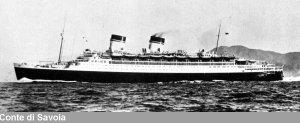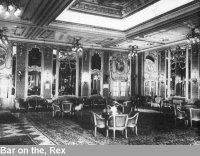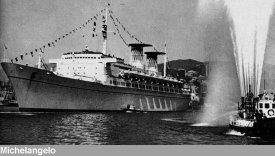

|
       |  The Italian nation, wouldn’t enter the large transatlantic "superliner" trade until after world war one. In 1926 the Navigazoine Generale Italiana, or N.G.I. with the help of Edna Mussolini the daughter of dictator, Benito Mussolini, would launch the largest Italian liner to date, the 30,400 ton motor vessel Augustus.
Augustus would achieve the distinction of becoming the largest diesel-powered liner ever built. In the early 1930’s the large Italian lines, The Lloyd Sabaudo Line, the Cosulich Line and the N.G.I., were facing financial ruin. Mussolini would encourage the three struggling lines to merge and become megalithic Societa ‘Italia’ di Navigazione, or Italia Line. Mussolini encouraged the new line to build a new Atlantic superliner, in hope of capturing the Blue Riband for Italy. The N.G.I. was already advanced in the construction of the great 51,000 ton Rex. The 48,500 ton Conte di Savoia was also nearing completion and the two new liners would enter into service just two months apart in 1932. The Rex was the first into service, but teething problems would plague her maiden voyage in September of 1932. While still within Mediterranean waters, the Rex’s engines failed, the ship had to wait three days at Gibraltar for repairs. But the Rex would eventually prove herself a thoroughbred, taking the Blue Riband for Italy in August of 1933, with a passage of 4 days, 13 hours. The Conte di Savoia entered service two months after the Rex, in November of 1932. Her maiden voyage would also run into trouble, when 900 miles west of the American mainland, and outlet valve below the waterline jammed and blew a large hole in the ship’s hull. "Very The Italian nation, wouldn’t enter the large transatlantic "superliner" trade until after world war one. In 1926 the Navigazoine Generale Italiana, or N.G.I. with the help of Edna Mussolini the daughter of dictator, Benito Mussolini, would launch the largest Italian liner to date, the 30,400 ton motor vessel Augustus.
Augustus would achieve the distinction of becoming the largest diesel-powered liner ever built. In the early 1930’s the large Italian lines, The Lloyd Sabaudo Line, the Cosulich Line and the N.G.I., were facing financial ruin. Mussolini would encourage the three struggling lines to merge and become megalithic Societa ‘Italia’ di Navigazione, or Italia Line. Mussolini encouraged the new line to build a new Atlantic superliner, in hope of capturing the Blue Riband for Italy. The N.G.I. was already advanced in the construction of the great 51,000 ton Rex. The 48,500 ton Conte di Savoia was also nearing completion and the two new liners would enter into service just two months apart in 1932. The Rex was the first into service, but teething problems would plague her maiden voyage in September of 1932. While still within Mediterranean waters, the Rex’s engines failed, the ship had to wait three days at Gibraltar for repairs. But the Rex would eventually prove herself a thoroughbred, taking the Blue Riband for Italy in August of 1933, with a passage of 4 days, 13 hours. The Conte di Savoia entered service two months after the Rex, in November of 1932. Her maiden voyage would also run into trouble, when 900 miles west of the American mainland, and outlet valve below the waterline jammed and blew a large hole in the ship’s hull. "Very  quickly, sea water began to fill the ship’s dynamo compartment, the situation became quite serious, initial inspections revealed that the liner might actually sink, within as little as five hours. But the ship’s engineers were very resourceful and one member of the crew went below and, in great danger, filled the hole with cement". The ship would then continue safely to New York. (McAuley, 1998:77).
The Conte di Savoia would never capture the Blue Riband, she was however more renowned for her ‘stabilising equipment’. She was the first major liner to have a gyro-stabiliser system, a system that predated modern fin stabilisers. The experiment was only partially successful, it could only be used on westbound passages, because of prevailing winds and it had no effect on the pitching movement of the ship in a seaway. Both ships would pioneer a ‘resort’ setting at sea, their owners claiming that "The Riviera comes to meet you on board the Rex and Conte di Savoia." Grand lido decks were the highlight on both ships quickly, sea water began to fill the ship’s dynamo compartment, the situation became quite serious, initial inspections revealed that the liner might actually sink, within as little as five hours. But the ship’s engineers were very resourceful and one member of the crew went below and, in great danger, filled the hole with cement". The ship would then continue safely to New York. (McAuley, 1998:77).
The Conte di Savoia would never capture the Blue Riband, she was however more renowned for her ‘stabilising equipment’. She was the first major liner to have a gyro-stabiliser system, a system that predated modern fin stabilisers. The experiment was only partially successful, it could only be used on westbound passages, because of prevailing winds and it had no effect on the pitching movement of the ship in a seaway. Both ships would pioneer a ‘resort’ setting at sea, their owners claiming that "The Riviera comes to meet you on board the Rex and Conte di Savoia." Grand lido decks were the highlight on both ships  and included reclining deck chairs, coloured umbrellas, shading several tiled pools which were above decks. They were the first examples of a floating resort. Inside, the interior design would reflect the illustrious age of Italian Baroque.
As wonderful as these two ships were, they only ever sailed half-full. They had appeared in a period of economic decline and were too quickly eclipsed by the enormous, chic and fast Normandie and Queen Mary. The Rex and the Conte di Savoia would continue commercial services through the early months of the second world war. Except for neutrality markings painted along their sides, the ships continued services until Mussolini revealed himself as Hitler’s ally. Both of the Italian superliners would be lost during the war. The first to go was the Conte di Savoia, after some scattered trooping, she was laid up in Venice, where Amercian bombers sank her on 11th September 1943. The Rex would outlive her sister by only a year, when on the 7th of September 1944, aircraft from the Royal Air Force caught her under tow off Cape d’Istria near Trieste, apparently the and included reclining deck chairs, coloured umbrellas, shading several tiled pools which were above decks. They were the first examples of a floating resort. Inside, the interior design would reflect the illustrious age of Italian Baroque.
As wonderful as these two ships were, they only ever sailed half-full. They had appeared in a period of economic decline and were too quickly eclipsed by the enormous, chic and fast Normandie and Queen Mary. The Rex and the Conte di Savoia would continue commercial services through the early months of the second world war. Except for neutrality markings painted along their sides, the ships continued services until Mussolini revealed himself as Hitler’s ally. Both of the Italian superliners would be lost during the war. The first to go was the Conte di Savoia, after some scattered trooping, she was laid up in Venice, where Amercian bombers sank her on 11th September 1943. The Rex would outlive her sister by only a year, when on the 7th of September 1944, aircraft from the Royal Air Force caught her under tow off Cape d’Istria near Trieste, apparently the  Germans planned to sink the ship in the harbour as a block ship. Over the next forty-eight hours the ship had rockets fired into her side, until she lay capsized and burning.
After world war two, the Italians lost much of their shipping tonnage to the allies. Their fortunes would recover and launch two large ships in 1954, the Cristoforo Columbo and the Andrea Doria, which was lost in a collision with a Swedish liner Stockholm in fog on the 25th of July, 1956. In 1960, the Italia line would launch an even larger ship, the Leonardo da Vinci of 33,000 tons. Later in the 1960’s The Italians capitalised on a short lived European sea travel revival, with the building of two 45,000 ton sister ships, The Michelangelo and Raffaello, of 1965. These ships were initially popular, but were taken out of service in the early 1970’s when passenger trade collapsed. The ships would later sail on for other lines, and would eventually be scrapped. ...(bibliography). (italian liners gallery)... Germans planned to sink the ship in the harbour as a block ship. Over the next forty-eight hours the ship had rockets fired into her side, until she lay capsized and burning.
After world war two, the Italians lost much of their shipping tonnage to the allies. Their fortunes would recover and launch two large ships in 1954, the Cristoforo Columbo and the Andrea Doria, which was lost in a collision with a Swedish liner Stockholm in fog on the 25th of July, 1956. In 1960, the Italia line would launch an even larger ship, the Leonardo da Vinci of 33,000 tons. Later in the 1960’s The Italians capitalised on a short lived European sea travel revival, with the building of two 45,000 ton sister ships, The Michelangelo and Raffaello, of 1965. These ships were initially popular, but were taken out of service in the early 1970’s when passenger trade collapsed. The ships would later sail on for other lines, and would eventually be scrapped. ...(bibliography). (italian liners gallery)...FastCounter by bCentral People have visited this page since; 11/6/96 | Ocean Liners | Links | View Guestbook | Sign Guestbook | E-mail | |